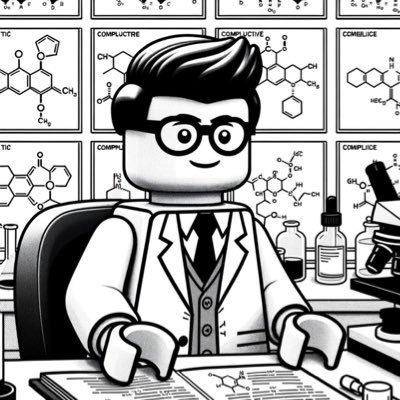
BenCree
@ChemCree
Followers
263
Following
427
Media
14
Statuses
592
Postdoc @RIKEN, PhD from @ColegroupNCL Newcastle University. Computational Chemist/Drug Design & Open Source Dev. Fan of SC2. An English flavoured scientist.
Joined February 2020
📢 Call for proposals: Boltz small-molecule design collaboration! 🧬 Can we help design your ideal molecule? Can you help us improve our open-source models? Please reach out or share with scientists you know! More details below! It has been great to see the level of excitement
4
68
261
A surprising & little-known results in classical statistics: Mean (μ) and median (m) are within one std deviation: |μ−m| ≤ σ For unimodal densities, bound is even tighter |μ−m| ≤ 0.7746 σ This beautiful results first appeared in a 1932 paper by Hotelling & Solomons 1/3
27
193
2K
You can estimate logarithms base 10 without a calculator with the approximation (x - 1)/(x + 1).
10
22
204
Transforming molecular machine learning with stereoelectronics-infused molecular graphs (SIMGs) Traditional molecular representations in machine learning often overlook essential quantum-mechanical effects, limiting predictive power in complex chemical systems. In my latest
1
13
72
A new flagship quantum chemistry dataset is out! Omol25 contains more than 100 million DFT calculations across an expanse of chemical space. Collaborating with the FAIR team on this has been super fun! https://t.co/kPJHqPdvwH
arxiv.org
Machine learning (ML) models hold the promise of transforming atomic simulations by delivering quantum chemical accuracy at a fraction of the computational cost. Realization of this potential...
3
26
147
Today in @Nature, we’re presenting GenCast: our new AI weather model which gives us the probabilities of different weather conditions up to 15 days ahead with state-of-the-art accuracy. ☁️⚡ Here’s how the technology works. 🧵 https://t.co/PWCNWbQnlU
122
919
5K
this is lit. so satisfying to see conv nets in action man!
28
394
3K
Here's the last paper from my time in @FrankNoeBerlin's group. We use normalizing flows (NF) to build a whole phase diagram from just two MD simulations. Especially useful for ML potentials, since it requires much fewer energy evaluations than traditional methods!
Efficiently #MachineLearning phase diagrams with conditional Boltzmann Generators for Materials. By Max Schebeck, @inve_michele and Jutta Rogal! https://t.co/qI67ZH4zq3
2
18
112
Boltz-1: Democratizing Biomolecular Interaction Modeling 1. Boltz-1 introduces the first fully open-source model achieving AlphaFold3-level accuracy in predicting 3D structures of biomolecular complexes, democratizing access to cutting-edge structural biology tools. 2. The
2
14
81
@EddieMillar @Sam_Dumitriu Hmm. We can put boundaries around it. NICE use ~£25k as value of extra quality year for humans. £100m is value of 4000 extra years. Bats live ~15 years, so that 266 bats if valued same as humans….. How big is the colony and how do you value bats vs humans?
1
1
1
Introducing SRME: a new metric for further assessment of foundational machine learning interatomic potentials! 👉A smaller SRME value indicates better performance for calculating thermal conductivity 🖥️ https://t.co/Hj04CVNeTf Huge thanks to Janosh @jrib_ & Yuan @cyrusyc_tw
🚀Introducing autoWTE: using foundational machine learning Interatomic Potentials, phono3py & fine-tuning to accurately predict Wigner Thermal conductivity for crystals of any structure or composition🧊🔍 🌡️: https://t.co/yU5a1lmB4R
#ThermalConductivity #MatbenchDiscovery
2
12
53
We’ve just finished writing the missing 15,616 Wikipedia articles to get complete coverage of all 19,255 human genes. We used PaperQA2, which has higher accuracy than existing human-written Wikipedia articles, as judged by blinded biology PhD students and postdocs. 1/5
22
140
728
OpenDock: A PyTorch-Based Open-Source Framework for Protein-Ligand Docking and Modeling • A paradigm shift in molecular docking: OpenDock, built on PyTorch, offers an open-source framework with unparalleled flexibility for protein-ligand docking, integrating both classical and
1
40
123
There's been one paper I can't get out of my head for the past month, and it's Oliver Unke & Martin Stohr's work studying peptide and protein dynamics with NNPs. Here's why I think this work is so impactful, and what it means for the field: https://t.co/krUbVT46uP
corinwagen.github.io
A recent paper uses NNPs to simulate proteins and finds that they may be significantly more flexible than we realized.
1
11
82
Switching between plotting libraries lets you leverage their unique strengths. However, learning multiple specific APIs can significantly increase your cognitive load. hvPlot provides a unified, high-level API that allows using the same syntax for Bokeh, Matplotlib, and Plotly.
1
11
44
🎉 Results of CACHE Challenge #2 are out! Five top-scoring teams from around the 🌍 used #AI, #CitizenScience, and #OpenSource tools to identify 7 promising hits that could lead to a pan-coronavirus treatment. Dataset is now publicly available to all!
conscience.ca
Researchers from across the globe identified seven promising early-stage molecules that could lead to a new treatment effective against all coronaviruses.
2
10
19
Pleased to see one of our compounds amongst the highest scoring in round 1, which we were able to follow up with free energy calculations in round 2. But more importantly we learned a lot about what we can improve when applying these methods in a prospective scenario
1
1
2
Very excited to have taken part in the CACHE2 hit finding challenge. Thank you so much to the organisers and well done to all the participants! We've written up some of our experiences in this blog: https://t.co/iZ01JVJtqx
@ChemistryNCL @SciencesNCL
cole-group.github.io
Recently a team of us from Newcastle University were fortunate enough to enter the second Critical Assessment of Computational Hit-Finding Experiments (CACHE) Challenge. The full team comprised: Ben...
Announcing CACHE2 results! Crowdsourcing and conventional methods did as well as novel ML. Teams started from 4 fragments in the PDB. We tested their predictions and found double-digit µM hits. This is the state-of-the-art. @thesgconline @consciencemeds
https://t.co/Fbut1xK0yQ
1
8
21
blog: recreating an interesting visualization of electrostatic potentials with rdkit and matplotlib https://t.co/9Cr1O04QAF
0
9
63






















